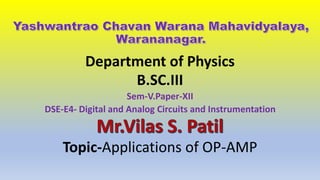
Applications of OPAMP.pptx
- 1. Department of Physics B.SC.III Sem-V.Paper-XII DSE-E4- Digital and Analog Circuits and Instrumentation Topic-Applications of OP-AMP
- 2. • Applications of Op-4mps Inverting Amplifier : Fig. 2.14(a) shows the circuit diagram Op-Amp as inverting amplifier. If only one input is applied to the a input terminal, then it is called as inverting amplifier. The positive input terminal is grounded and input voltage V1 is applied to the negative input terminal of amplifier through resistor R1. The negative feedback is applied through Ro from output terminal to input terminal. The feedback resistor R0 and input resistor R1 determines the inverting operation. For an ideal Op- Amp open loop gain is infinite. Hence, potential difference between the input terminal must be zero. Hence, Vs = 0, by negative feedback around the amplifier. Again input impedance of an ideal Op-Amp is infinite, hence input current to the amplifier will be zero. The voltage Vs = 0 indicates that terminal 1, has same potential as terminal 2. Since terminal 2 is grounded, terminal 1 is also virtually grounded. Thus, current II flowing through R1, must be flowing through R. Hence we have
- 3. Inverting Amplifier : Hence 𝐼1= 𝐼0 𝑉1−𝑉𝑠 𝑅1 = 𝑉𝑠−𝑉0 𝑅0 But 𝑉 𝑠 = 0 ∴ 𝑉1 − 0 𝑅1 = 0 − 𝑉0 𝑅0 𝑉1 𝑅1 = −𝑉0 𝑅0 𝑉0 𝑉1 = −𝑅0 𝑅1 AcL = 𝑉0 𝑉1 = −𝑅0 𝑅1 = is closed loop gain of inverting amplifier. It is negative because closed loop amplifier reverses the sign of input signal. That is output is out of phase with input. The closed loop gain depends upon the ratio Ro/Ri • Non-inverting Amplifier : Fig.2.15(a) shows the circuit diagram of an ideal Op-Amp in non-inverting mode. The equivalent circuit of non- inverting mode is shown in Fig. 2.15(b). The input signal is applied to the non-inverting terminal (+). The feedback is applied to the inverting input terminal (—) through Rf. The resistors Rf and R1 from the feedback voltage divider circuit. In this case also Vs = 0. The voltage V1 from the negative terminal to ground is equal to the input voltage V2. In this case V1 is not equal to zero i.e. non-inverting circuit has no virtual ground at either one of its input terminals.
- 4. Non-inverting Amplifier : • Since
- 5. 2.7.3 : Op-Amp as Adder : An adder is a circuit whose output is proportional to the algebraic sum of the input voltages. It is same as the inverting amplifier except that it has several input terminals. Consider an inverting amplifier with 3 inputs at inverting terminal as shown in Fig. 2.16. The inverting terminal is virtually ground by the feedback resistor R0. Hence, sum of currents through R1, R2, R3 is equal to the current through R0. • Thus, we obtain the sum of the voltages at the output. Hence Op-Amp works as an adder
- 6. The Op-Amp as subtractor is also known as difference amplifier. The function of a subtractor is to give output which is proportional or equal to the difference of the two input signals. The input signals are applied at the both inverting and non- inverting terminals as shown in Fig. 2.17. • Both inverting and non-inverting operations take place simultaneously. Applying principle of superposition output voltage Vo is given as, Vo = Vo1 +V02 • V01 and V02 are outputs due to V1 and V2, simultaneously. The output V01 due to V1 alone with the other input earthed is same as that of inverting circuit. ∴ 𝑉01 = −( 𝑅𝑓 𝑅1 )𝑉1 • The output V02 due to V2 alone with the other input earthed is the same as that of non-inverting circuit. • Thus the output voltage is the difference between two input voltages.
- 7. • 2.7.5: Op-Amp as Differentiator : Fig. 2.18(a) shows a circuit used to study Op-Amp as differentiator. Its equivalent circuit is shown in Fig. 2.18(b). • Fig. 2.18 : (a) Op-Amp as differentiator, (b) Equivalent circuit. • The input signal source of voltage V(t) is connected to the inverting input terminal through a capacitor C. The non- inverting input terminal is earthed. Negative feedback is given through a resistance R. Let V(t) be the signal voltage given as input which gives varying current through the capacitance C. From equivalent circuit we have I=C 𝑑𝑉(𝑡) 𝑑𝑡 Output voltage 𝑉0 = −𝐼𝑅 = −𝑅𝐶 𝑑𝑉(𝑡) 𝑑𝑡 Thus output voltage is time derivative of input voltage. Hence Op-Amp work as differentiator.
- 8. • Op-Amp as Integrator : Fig. 2.19(a) shows a circuit diagram of Op-Amp as an integrator. Here the output voltage is proportional to the time integral of the input voltage. Fig. 2.19(b) shows an equivalent circuit of an Op-Amp as a integrator. • (a) Op-Amp as Integrator, (b) Equivalent circuit. Here input current to the ideal Op-Amp is zero and the feedback through the capacitor C forces the virtual ground to exist at the inverting input terminal. Hence output voltage is the voltage across C. • ∴ 𝑉0 = − 1 𝐶 𝐼𝑑𝑡 = − 1 𝑅𝐶 𝑉𝑑𝑡 • Therefore, the amplifier provides an output voltage proportional to the integral of the input voltage.